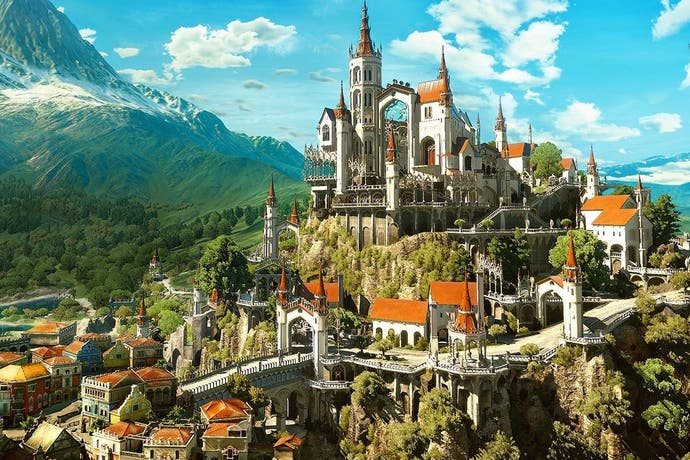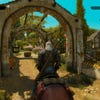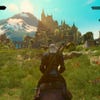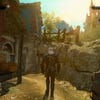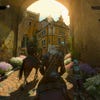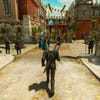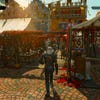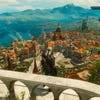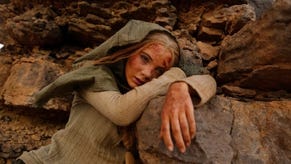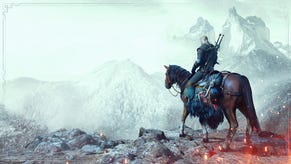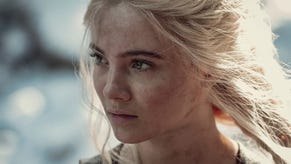Does The Witcher 3 expansion fulfil the original graphics promise?
Digital Foundry on Blood and Wine's impressive new area.
The upcoming Blood and Wine expansion for The Witcher 3 has some of the most striking areas seen running on REDengine 3, and for those who felt The Witcher 3 fell short of its ambitious E3 showings, it marks a strong comeback. Set around the richly detailed, rose-adorned kingdom of Toussaint, its central castle has parallels with the bustling Novigrad city of the main game. That original Novigrad area came under scrutiny at the game's launch - serving as an example of how CD Projekt Red's vision had changed by release. Can Toussaint be a redemptive moment for the studio?
Turn back the clock to E3 2014, and Geralt took us on a horseback tour through the incredible Novigrad hub - a vibrant, colourful harbour brimming with NPCs. Much of this promise came to bear in the final product, but it was hard to overlook some of its omissions. Lighting became visibly flatter in the transition from the showfloor to the home experience - and missed the crisper, saturated look we enjoyed on first sighting. Assets were also notably changed too; we got lower-resolution floor textures, and draw distances were reined in across the city. A compromise was apparent.
Even at maximum settings on PC, we didn't get an exact match for that original display of Novigrad. However, with the engine changes promised for this latest expansion, realising that level of ambition elsewhere is now a more feasible prospect. In a recent interview with Eurogamer, senior environment artist Len de Gracia explains this expansion uses a brand new approach to rendering The Witcher 3's environments. The team started off from scratch in building all the details in this region to cater to this new method - from the sun-kissed stone arches to the rose vines coiling around its central castle.
The payoff is evident in its final delivery on PC. This new system essentially groups assets (such as textures, geometry and shaders) together in larger clusters, demanding fewer referrals to the CPU on any machine. It's a smarter management of resource that means we can get a visual boost over the base game, and at a lower performance penalty where the CPU is a bottleneck.
"We've employed methods that we did not implement in the base game," Gracia explains. "Before, each and every prop had its own texture; this might require another draw-call or so. It impacts performance. But this time around we know we're going to group these things together so you have them representing the same texture now. So we're loading less but maximising the quality at the same time."
For now, these optimisations aren't in effect for The Witcher 3's main game content, stuck as it is with the original method for streaming in assets. And of course, the real test of its efficacy will be on console, where PS4 and Xbox One struggled at launch to hit a solid 30fps (we only have the PC version available for now). It's clear those versions struggle with the more complex geometry of big cities like Novigrad, in which objects, textures and even characters pop in suddenly ahead. Each draw call to the CPU creates a momentary stutter, but CD Projekt Red's new approach could minimise this to an extent - while also opening the gates to more visual flourish.
But does Blood and Wine deliver on that earlier E3 promise? In terms of what we're getting in the best case scenario on PC, Toussaint's castle town is undoubtedly a gorgeous area. It explodes with colour in a way no other locale does, and in that sense, direct comparisons with the likes of Novigrad's harbour aren't precisely fair. But the sheer level of its detailing, the vibrant colour palette, and sense of scale are unparalleled on the PC game - and especially so in terms of the variety of materials. It's clear the team's adapted method opens the gates to more extravagant ideas, with more variety.
This is partly what went missing on The Witcher 3's release. The town takes influences from southern France, where unique points of detail are in abundance; we have crisp, high-resolution murals lining its walls, roads are patterned with new designs, plus a new frosted glass shader for its packed greenhouses. Each area is distinct, and in its own way, the picture revives the same sense of wonder we experienced in earlier showings of the game.
There's more to uncover in this expansion as we go, and for a full breakdown of Blood and Wine's content you can read our review right here. The prospects look good for the final update to The Witcher 3, though; the most picturesque area of the game, and a grand final bow from the studio before it moves on to its new Cyberpunk 2077 project. On the technical front, our footage of Toussaint is delivered at maximum settings on PC - where a Titan X obviously ensures 60fps. But of course, the real challenge for CD Projekt Red will be getting this area running stutter-free on PS4 and Xbox One. Given the game's previous history on console - and the run of patches attempting to correct its hitches - it'll be interesting to see how this new region fares.
